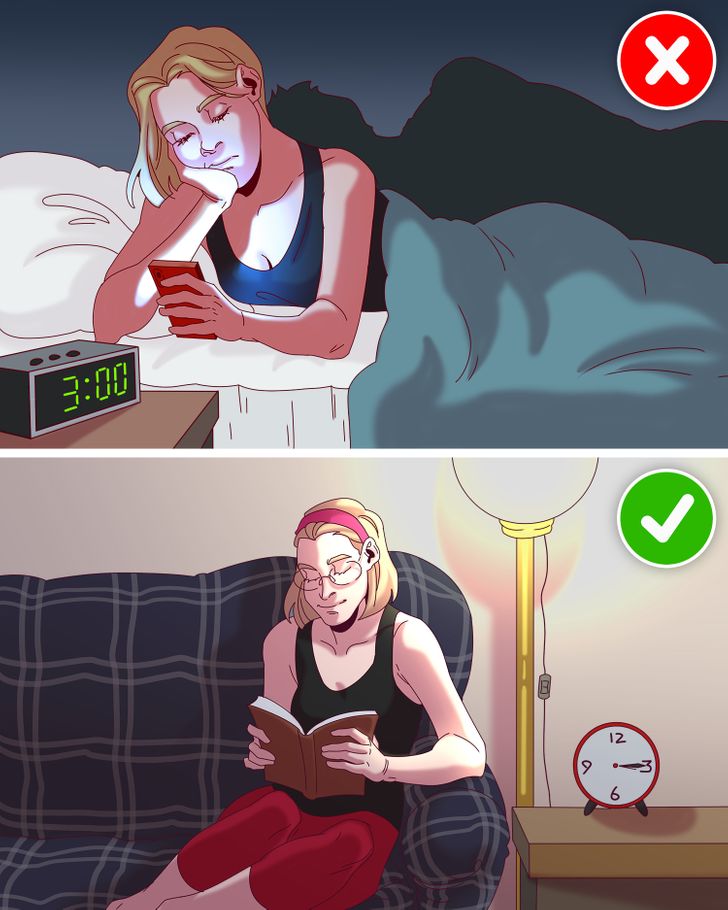Sleeping with another person not only provides us with feelings of safety and security, bonding, and closeness, but it also has considerable health benefits, like lowering levels of cortisol or reducing inflammation. It’s a nice addition to experience, all things considered.
Yet some people just seem sleep-incompatible. Opposing sleep cycles, snoring, blanket-hogging, and more are just obstacles that lead to low cortisol levels. But let’s not give up — there are many compromises we can make in terms of bed real estate.
It always pains us at Bright Side to see relationships get ruined by minor issues. So we gathered some common problems that affect couples at bedtime and want to share them with you.
1. Blanket tug-of-war

Some sleepers are just not into blanket-sharing. You go to sleep with your relationship being 50/50, but the next thing you know, it’s freezing cold, you’re curled up in a corner, and shivering. There’s no blanket left for you! It’s futile to try to pull it back since the hogging will just happen again. Despite the comical nature of the blanket controversy, it can actually stiffen your relationship and have a bad impact on the quality of your sleep.
- Solution: A bigger bed and separate blankets will do the trick! This way, both of you can have your own sleeping materials with no need for “stealing” from each other. Ask if your partner is comfortable at night — perhaps, they’re freezing, which is why they hog the covers so much.
2. Snoring

Imagine you’re snoozing, feeling warm and comfy in your bed, and suddenly, a locomotive’s horn tuts right above your ear. Nope, it’s not an emergency alert, it’s just your beloved failing to push the air through their nose properly.
As a single incident, snoring is not a big deal, but in a worst-case scenario, it can be a symptom of a bigger problem. It sabotages bedtime for both parties, leaving the snorer with headaches, weariness, and other evidence of sleep deprivation the next day.
- Short-term solution: Change the sleeping position since snoring appears most often when we sleep on our backs. Lifting up the head might also help. Go to bed before the snorer and use earplugs. Keep some distance between you, if needed.
- Long-term solution: Lifestyle changes, such as losing weight, sticking to a sleep schedule, and avoiding alcohol, smoking, and certain medications can help. If the snoring is still happening often, it’s better to see a doctor.
3. Different temperature preferences

66°F to 69°F (19°C to 20.5°C) is considered an optimal sleeping temperature for most people, but sometimes it can slightly vary. You can discover that your partner’s preferable “sleeping settings” differ from yours. With uncomfortable ambient temperature, it takes longer to fall asleep. It’s harder to get into a deep sleep as well, so you might have trouble staying asleep.
- Solution: Get separate bedding to better fit the needs of each of you. It’s difficult to sleep when you’re overheated, so it’s easier for the person who likes to be warmer to compromise. If your partner’s preferable temperature is lower than yours, opt for more blankets and wearing warmer pajamas.
4. Nighttime wake-ups

Unprompted waking up in the middle of the night isn’t uncommon. It can be a sign of insomnia or a result of stress, electronic-use, a poor sleep environment, or just a unique sleep schedule. When you wake up and can’t get back to sleep after 15 or 20 minutes, there’s no point in just lying here. And if it happens frequently, the first thing to remember is to be courteous toward your partner.
- Short-term solution: Get out of bed, go into a separate room, and do something calming until you feel drowsy again. But don’t do anything while you’re next to your partner. Come back to the bedroom only when you’re ready to go back to sleep.
- Long-term solution: Improve your sleep hygiene. Make sure your bedroom is dark, quiet, and fresh. Stop looking at screens near bedtime. Don’t eat or drink caffeine before bed. Adopt a relaxing nighttime routine and aim for a consistent bedtime.
5. Night sweats

You slipped into a fresh, cool bed and everything seems perfect. But as hours tick on and 2 people’s bodies heat up the environment, many people start to get sweaty. Night sweats can quickly turn into a joint problem if you use one blanket or cuddle in your sleep. Surely, cuddling or even laying close to a sweating person is uncomfortable.
- Solution: Sleeping environments and bedding design are the most common reasons why people get hot in their sleep. Get yourself a mattress with cooling properties and use breathable clothing and sheets, like airy linen. But night sweats can also be a result of various conditions, and in that case, it’s strongly recommended to visit a doctor to sort things out.
6. Clashing sleep cycles

This is known as the early bird vs night owl war. We all have our own “chronotype” that reigns over our internal sleep clock. It may change as we get older: young adults peak in “eveningness” and grow to be “morning types” with age.
If you’ve realized that you and your partner have an opposing circadian rhythm, it’s important to follow your own sleep schedule and live according to your chronotype. Evening people who try to go to bed too early might end up with insomnia since the pressure to sleep when the body is not ready triggers anxiety and frustration.
- Solution: It’s okay to go to bed at different times. Lighting can help to slightly shift the sleep schedule. Your body starts to produce a “sleep hormone,” known as melatonin, when it’s dark and stops as it gets lighter, telling us it’s time to wake up. So, bright light exposure in the morning and poor light exposure in the evening may help night owls to move their waking hours a bit.
7. Children in the bed

Sharing a bed with one partner is already a feat on its own, but adding a child to the mix can really ruin your nighttime rhythm. You’re suddenly awoken, your sleep is disrupted, and the child crawls into bed, taking up more space. The marriage can become tense because of this, especially if someone has to leave to make room, and parents often feel stuck in situations like this.
- Solution: It’s time to toughen up and lead the kid back to their bed. It’s crucial for them to learn how to fall asleep and do so independently. Co-sleeping can have long-term behavioral and cognitive consequences for a child, and it can completely ruin sleep health for parents. And the child is unlikely to grow out of this habit.
What sleeping problems do you or your family members have?
Comments
Post a Comment